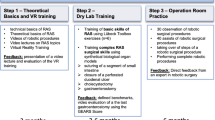Abstract
The robotic surgical platform is being utilized by a growing number of hospitals across the country, including academic medical centers. Training programs are tasked with teaching their residents how to utilize this technology. To this end, we have developed and implemented a robotic surgical curriculum, and share our initial experience here. Our curriculum was implemented for all General Surgical residents for the academic year 2014–2015. The curriculum consisted of online training, readings, bedside training, console simulation, participating in ten cases as bedside first assistant, and operating at the console. 20 surgical residents were included. Residents were provided the curriculum and notified the department upon completion. Bedside assistance and operative console training were completed in the operating room through a mix of biliary, foregut, and colorectal cases. During the fiscal years of 2014 and 2015, there were 164 and 263 robot-assisted surgeries performed within the General Surgery Department, respectively. All 20 residents completed the online and bedside instruction portions of the curriculum. Of the 20 residents trained, 13/20 (65 %) sat at the Surgeon console during at least one case. Utilizing this curriculum, we have trained and incorporated residents into robot-assisted cases in an efficient manner. A successful curriculum must be based on didactic learning, reading, bedside training, simulation, and training in the operating room. Each program must examine their caseload and resident class to ensure proper exposure to this platform.

Similar content being viewed by others
References
Wormer BA, Dacey KT, Williams KB, Bradley JF 3rd, Walters AL, Augenstein VA et al (2014) The first nationwide evaluation of robotic general surgery: a regionalized, small but safe start. Surg Endosc 28(3):767–776. doi:10.1007/s00464-013-3239-2
Salman M, Bell T, Martin J, Bhuva K, Grim R, Ahuja V (2013) Use, cost, complications, and mortality of robotic versus nonrobotic general surgery procedures based on a nationwide database. Am surg 79(6):553–560
Herron DM, Marohn M, Group S-MRSC (2008) A consensus document on robotic surgery. Surg Endosc 22(2):313–325. doi:10.1007/s00464-007-9727-5 (discussion 1–2)
Barbash GI, Glied SA (2010) New technology and health care costs—the case of robot-assisted surgery. New Engl J Med 363(8):701–704. doi:10.1056/NEJMp1006602
Buchs NC, Addeo P, Bianco FM, Gorodner V, Ayloo SM, Elli EF et al (2012) Perioperative risk assessment in robotic general surgery: lessons learned from 884 cases at a single institution. Arch Surg 147(8):701–708. doi:10.1001/archsurg.2012.496
Hung AJ, Zehnder P, Patil MB, Cai J, Ng CK, Aron M et al (2011) Face, content and construct validity of a novel robotic surgery simulator. J Urol 186(3):1019–1024. doi:10.1016/j.juro.2011.04.064
Maeso S, Reza M, Mayol JA, Blasco JA, Guerra M, Andradas E et al (2010) Efficacy of the Da Vinci surgical system in abdominal surgery compared with that of laparoscopy: a systematic review and meta-analysis. Ann Surg 252(2):254–262. doi:10.1097/SLA.0b013e3181e6239e
Rashid HH, Leung YY, Rashid MJ, Oleyourryk G, Valvo JR, Eichel L (2006) Robotic surgical education: a systematic approach to training urology residents to perform robotic-assisted laparoscopic radical prostatectomy. Urology 68(1):75–79. doi:10.1016/j.urology.2006.01.057
Schroeck FR, de Sousa CA, Kalman RA, Kalia MS, Pierre SA, Haleblian GE et al (2008) Trainees do not negatively impact the institutional learning curve for robotic prostatectomy as characterized by operative time, estimated blood loss, and positive surgical margin rate. Urology 71(4):597–601. doi:10.1016/j.urology.2007.12.023
Juza RMHRS, Won EJ, Enomoto LM, Pauli EM, Rogers AM, Singhal V, Tran TT, Estes SJ, LynSue JR (2014) Training current and future robotic surgeons simultaneously: initial experiences with safety and efficiency. J Robot Surg 8:227–231
Scozzari G, Rebecchi F, Millo P, Rocchietto S, Allieta R, Morino M (2011) Robot-assisted gastrojejunal anastomosis does not improve the results of the laparoscopic Roux-en-Y gastric bypass. Surg Endosc 25(2):597–603. doi:10.1007/s00464-010-1229-1
Seixas-Mikelus SA, Adal A, Kesavadas T, Baheti A, Srimathveeravalli G, Hussain A et al (2010) Can image-based virtual reality help teach anatomy? J Endourol/Endourol Soc 24(4):629–634. doi:10.1089/end.2009.0556
Stegemann AP, Ahmed K, Syed JR, Rehman S, Ghani K, Autorino R et al (2013) Fundamental skills of robotic surgery: a multi-institutional randomized controlled trial for validation of a simulation-based curriculum. Urology 81(4):767–774. doi:10.1016/j.urology.2012.12.033
Raza SJ, Froghi S, Chowriappa A, Ahmed K, Field E, Stegemann AP et al (2014) Construct validation of the key components of fundamental skills of robotic surgery (FSRS) curriculum—a multi-institution prospective study. J Surg Educ 71(3):316–324. doi:10.1016/j.jsurg.2013.10.006
Syana SRP, Gilla IS, Arona M, Hunga AJ (2013) Does virtual performance correlate with clinical skills in robotics? Investigating concurrent validity of da vinci simulation with clinical performance. J Urol 189(4):e643. doi:10.1016/j.juro.2013.02.3097
Stefanidis D, Acker CE, Greene FL (2010) Performance goals on simulators boost resident motivation and skills laboratory attendance. J Surg Educ 67(2):66–70. doi:10.1016/j.jsurg.2010.02.002
Rocco B, Lorusso A, Coelho RF, Palmer KJ, Patel VR (2009) Building a robotic program. Scand J Surg SJS Off Organ Finn Surg Soc Scand Surg Soc 98(2):72–75
Author information
Authors and Affiliations
Corresponding author
Ethics declarations
Funding
We did not receive any funding for this study.
Conflict of interest
EMP receives honoraria for speaking/teaching from Cook Biotech Inc. All other authors have no conflicts of interest.
Ethical approval
All procedures performed in studies involving human participants were in accordance with the ethical standards of the institutional and/or national research committee and with the 1964 Helsinki declaration and its later amendments or comparable ethical standards.
Rights and permissions
About this article
Cite this article
Winder, J.S., Juza, R.M., Sasaki, J. et al. Implementing a robotics curriculum at an academic general surgery training program: our initial experience. J Robotic Surg 10, 209–213 (2016). https://doi.org/10.1007/s11701-016-0569-9
Received:
Accepted:
Published:
Issue Date:
DOI: https://doi.org/10.1007/s11701-016-0569-9




